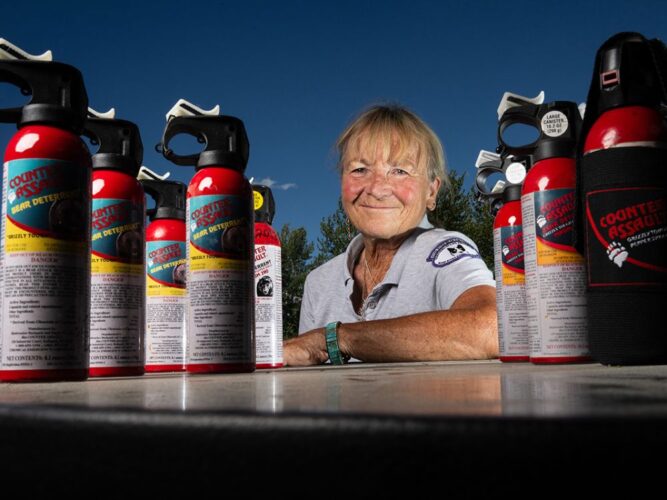Before bear spray, encounters between people and bears often ended in bullets. That changed when graduate student Carrie Hunt developed the life-saving deterrent at the University of Montana in the 1980s.
Over 40 years later, bear spray is one of the most important tools for human-wildlife coexistence.
Hunt grew up in Chile, where she spent her childhood reading “The Jungle Book” and training street dogs. As a zoology student in Montana, she learned how animals are wired and the science behind their behavior. These early experiences sparked a lifelong dedication to promoting coexistence between people and wildlife.
After college, Hunt spent three seasons with the Interagency Grizzly Bear Study Team in Yellowstone National Park. Over those three years, she saw nearly every female bear she knew get relocated and later put down after conflicts with people.
“By that time I was starting to become aware that this was a big problem for bears everywhere,” Hunt said. “I knew if I wanted to do something for bears, I would have to go back to school.”
Inspired by the work of famed bear researchers Frank and John Craighead, Hunt joined UM in 1981 under the direction of biologist and bear advocate Dr. Chuck Jonkel. With only $500 in funding for her research, Jonkel asked her to test the efficacy of skunk repellent on charging bears.
“This wasn’t what I wanted to do,” Hunt said. “But I thought about all those bears getting in trouble in Yellowstone and decided it wouldn’t be a bad idea to start looking at deterrents.”
Before widespread bear safety policies, the No. 1 reason for human fatalities in bear attacks was food-conditioned bears entering campsites at night. Hunt set out to find something that would deter a bear in a situation like that where it’s difficult to deploy a firearm. She also didn’t want to kill the bear during the process.
“I started testing old-timey remedies like moth balls around the tent, railroad flares, human urine and boat horns,” Hunt said. “I was willing to try anything.”
The light-bulb moment came when Hunt discovered Halt, a capsaicin-derived pepper spray that postmen used to deter dogs. A biologist in the Canadian arctic had once used the spray on a charging polar bear with some success. With so little literature on bear deterrents and even fewer field tests, Hunt figured it was worth a try.
At testing sites like trash dumps, she built triggers into their systems that would deter a bear if it tried to come inside.
“I wrote down if they charged, if they came back and how long they stayed away,” Hunt said. “And those were the first tests of bear spray.”
A host of organizations and agencies came together to support Hunt’s research, including Montana Fish, Wildlife and Parks; the British Columbia Ministry of the Environment; Glacier National Park; the Confederated Salish and Kootenai Tribes; and Jonkel’s Border Grizzly Project. Agencies and the public hoped for a solution to deadly bear conflicts.
Hunt’s early trials with Halt showed consistent results: The spray turned every bear she tested. But Halt could only spray a pencil-thin stream up to 6 feet, which required her testers to get very close to the bear to be effective. Hunt knew she was close to the right recipe, but she needed a better delivery system.

Hunt was approached by Bill Pounds, a Vietnam veteran suffering from Agent Orange exposure who was confident he could repackage bear spray with the right specifications. Together, they designed a canister with Hunt’s specifications that could spray a 3-foot-wide cone-shaped cloud up to 20 feet, eliminating the need to aim for a bear’s eyes and nose.
Pounds went on to found Counter Assault, one of the most popular brands of bear spray on the market and the first registered with the Environmental Protection Agency. Having no interest in running a business, Hunt happily handed over her recipe with the understanding that she would get free bear spray for life.
Following field tests of the newly repackaged bear spray, Hunt published her findings as her master’s thesis in 1984. Her work was featured in Life Magazine, and she wrote a report for the U.S. Fish and Wildlife Service that is the basis for federal bear spray requirements to this day.
Hunt spent the rest of her career developing nonlethal bear deterrents and repellants, including the use of rubber bullets and trained wildlife service dogs. She founded the Wind River Bear Institute in 1996, which trains Karelian bear dogs and their handlers to haze problem bears away from human spaces. Over the last 30 years, Hunt has built a network of biologists who learn her methods and carry on her vision for coexistence with bears.
“When I started all this, there was no science of human-wildlife conflict,” Hunt said. “I wanted to make a difference for bears and for how humans and animals relate to one another.”
By Libby Riddle, UM News Service

